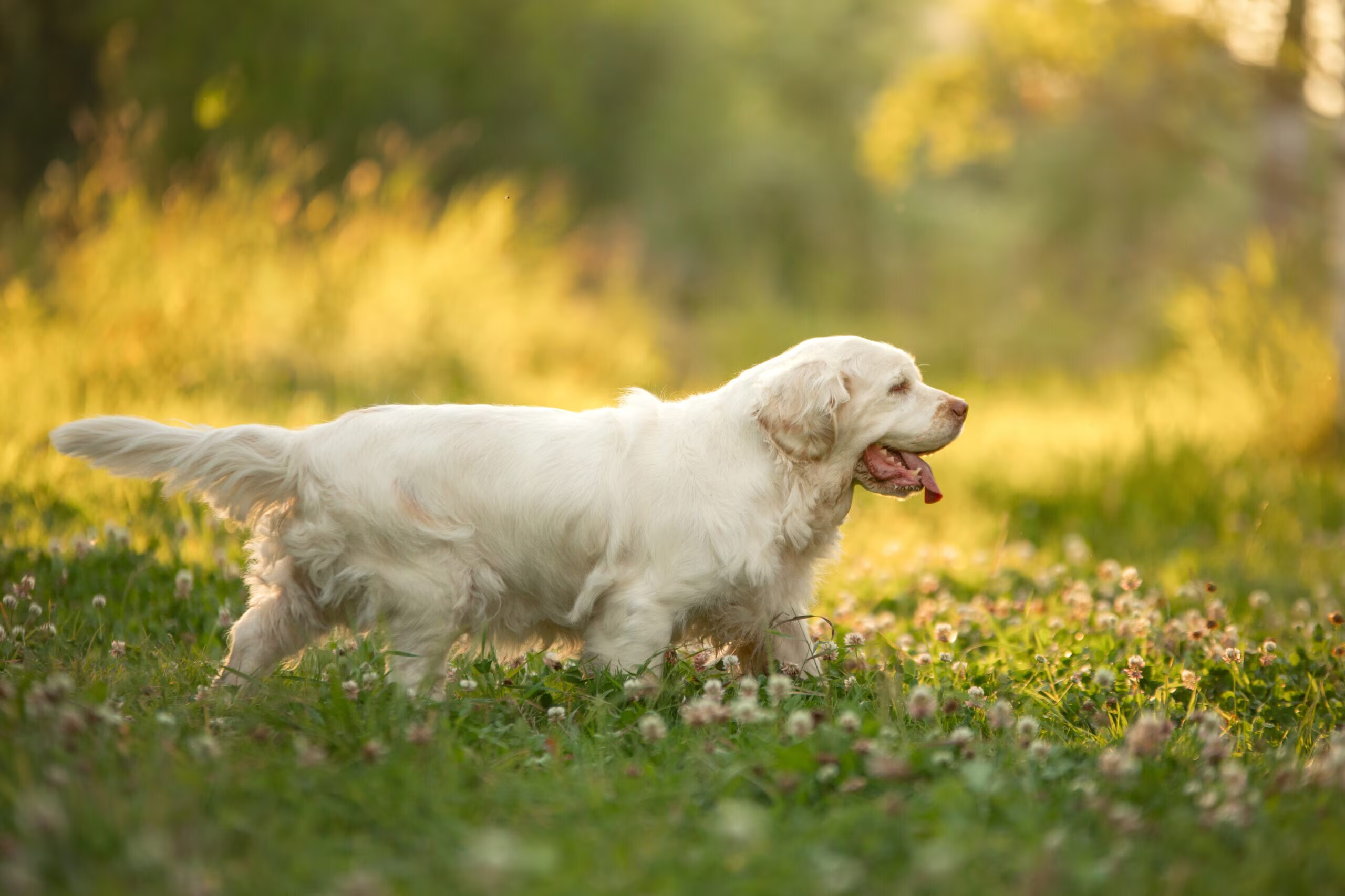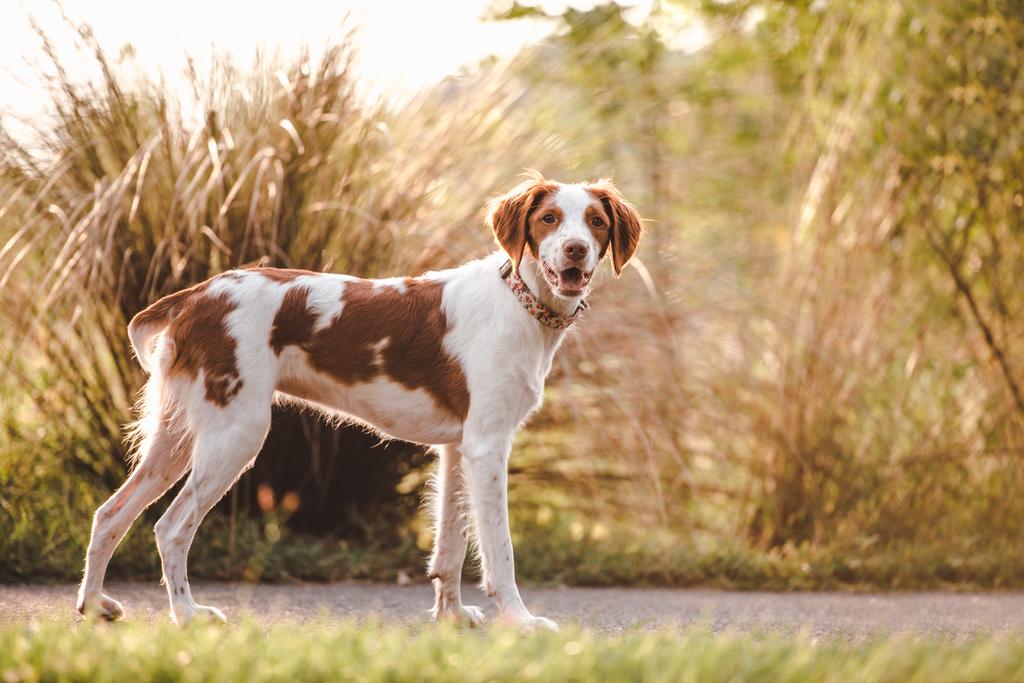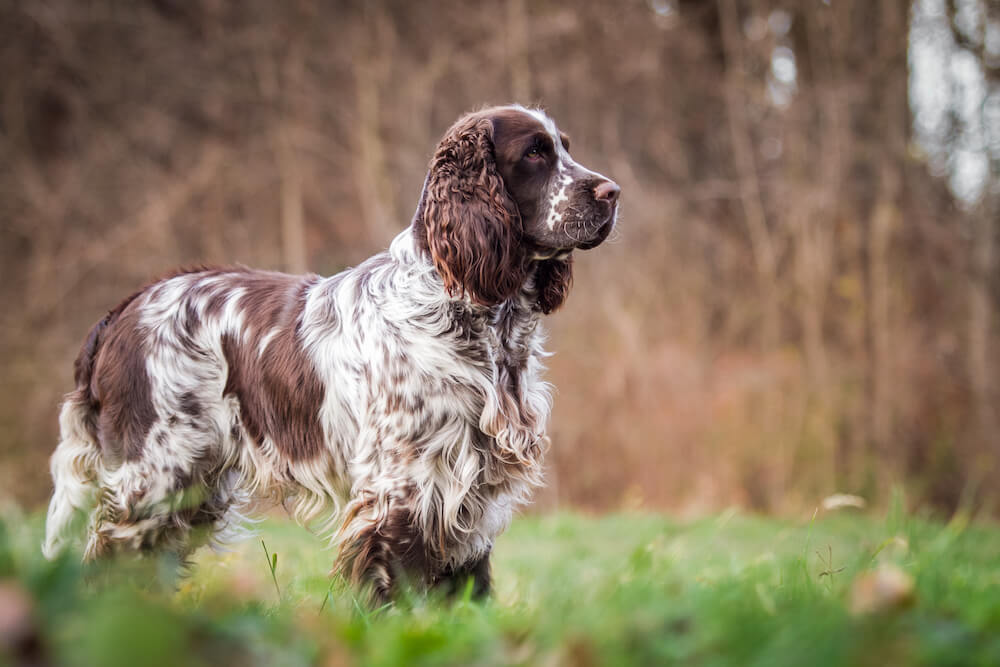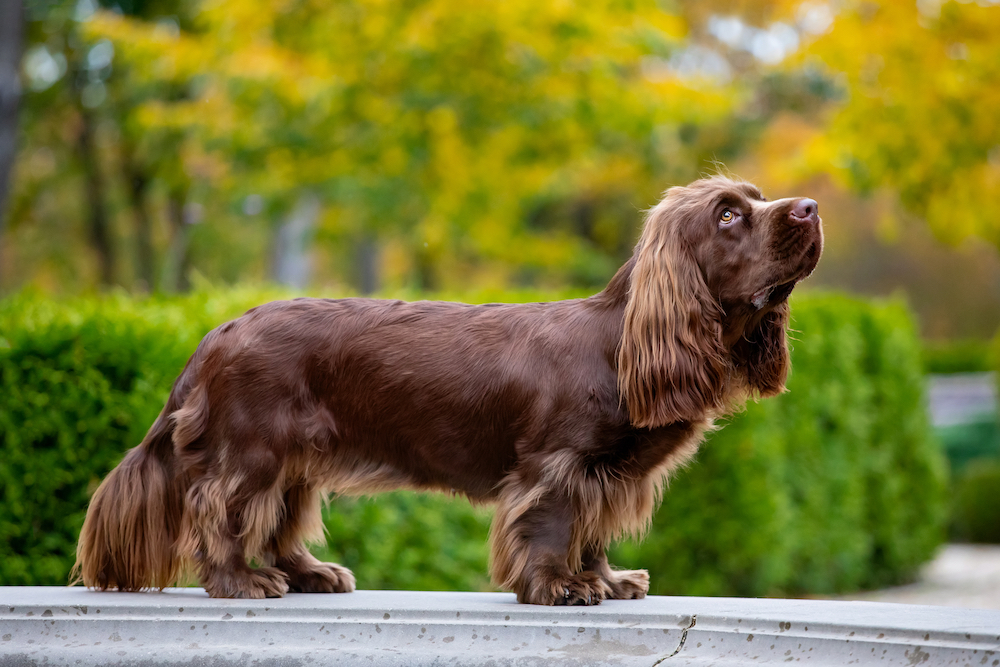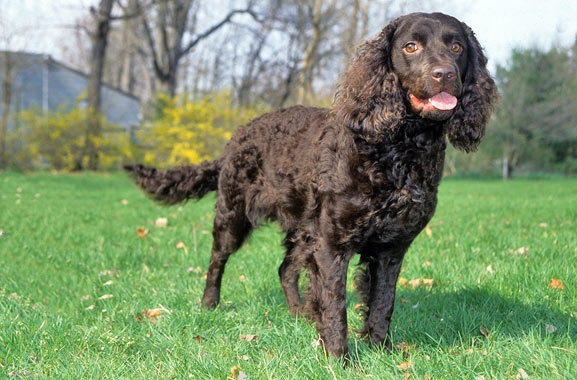Walking through a dog show years ago, I was drawn to an unusual sight – a group of substantial, cream-colored dogs with distinctively heavy heads and thoughtful expressions. They moved with a deliberate, rolling gait that spoke of power rather than speed. These weren’t your typical spaniels; they had a presence that commanded attention without demanding it. “Those are Clumber Spaniels,” a nearby handler told me, noticing my interest. “The aristocrats of the spaniel world.”
At pawtrix.wiki, we’re passionate about introducing dog lovers to breeds they might not encounter in their daily lives, and the Clumber Spaniel certainly qualifies. As one of the oldest spaniel breeds but also among the rarest, these gentle giants combine impressive physical strength with surprisingly gentle temperaments and a distinctive appearance unlike any other sporting dog.
Whether you’re considering adding one of these unique dogs to your family or simply expanding your canine knowledge, there’s much to learn about Clumber Spaniels. From their royal connections and near-extinction to their modern status as beloved companions, these cream-colored giants with the thoughtful expressions have a fascinating story and distinctive character that deserves recognition.
Throughout this article, we’ll explore everything you need to know about Clumber Spaniels – their aristocratic history, distinctive physical traits, temperament, care requirements, and whether they might be the right match for your lifestyle. By the end, you’ll understand why Clumber enthusiasts are so devoted to this special breed that combines the best qualities of sporting dogs with a uniquely calm, gentle approach to life.
Royal Heritage: From Palace Grounds to Present Day
The Clumber Spaniel boasts one of the most aristocratic histories of any dog breed, with roots deeply embedded in European nobility and a development shrouded in fascinating historical mystery.
Origins in Aristocracy
The exact origins of the Clumber Spaniel remain somewhat mysterious, but most historical accounts trace their beginnings to late 18th century France and England. The most widely accepted theory suggests they were developed around 1768 by the Duke of Noailles in France, who sought to create a spaniel that could work in heavy cover and dense woods.
When the French Revolution threatened aristocrats, the story goes that the Duke sent his prized kennel to England for safekeeping, specifically to the Duke of Newcastle’s estate, Clumber Park in Nottinghamshire – giving the breed both sanctuary and its name.
What’s certain is that by the early 19th century, Clumber Spaniels were well-established among the British aristocracy. They became particular favorites of British royalty, with Prince Albert (husband of Queen Victoria) and King Edward VII both keeping and breeding Clumbers. This royal connection helped cement their status as a prestigious breed for the upper classes.
The Working Heritage
Despite their association with nobility, Clumbers were developed as practical working dogs, specifically for a particular hunting style. Their unique build – powerful, low to the ground, with substantial bone – made them ideal for pushing through dense underbrush and briars where more lightly built dogs would struggle.
Clumbers typically worked in packs rather than individually, moving methodically through cover to flush game. They were valued for their excellent noses, determination, and ability to work all day at a steady pace rather than in bursts of speed. Their white coats helped hunters spot them in dense cover, an important practical consideration.
Unlike many sporting breeds that were expected to cover vast territories quickly, Clumbers excelled in smaller, heavily wooded estates where thorough, methodical hunting was more important than speed – a perfect match for the enclosed hunting estates of the European aristocracy.
Near Extinction and Modern Preservation
Like many specialized breeds, Clumber Spaniels faced challenges with the changing of times. The world wars were particularly difficult periods, when maintaining specialized dog breeds became a luxury few could afford. By the mid-20th century, Clumber Spaniels had become extremely rare.
Their salvation came through dedicated breed enthusiasts who recognized the value of preserving this historic breed. In both the UK and North America, small but dedicated groups of breeders worked to maintain the Clumber’s distinctive type and character while addressing health issues that had developed through years of limited breeding stock.
Today, while still rare, the breed has stabilized through careful breeding practices. Modern Clumbers maintain their distinctive appearance and gentle temperament while breeders work diligently to improve health and maintain genetic diversity. They remain listed as a “vulnerable native breed” by the UK Kennel Club, with annual registrations far below sustainable levels without dedicated preservation efforts.
Despite this rarity, the breed has maintained a devoted following who appreciate both its rich heritage and unique qualities. Modern Clumbers can be found competing in conformation shows, participating in hunting tests and field trials, and perhaps most importantly, serving as beloved companions in fortunate homes around the world.
Distinctive Appearance: The Unmistakable Clumber
There’s simply no mistaking a Clumber Spaniel for any other breed. Their distinctive appearance combines power with a certain dignified elegance that sets them apart from every other sporting dog.
Size and Structure: The Heavyweight Champion
Clumber Spaniels are the largest and heaviest of all spaniels:
- Males typically stand 18-20 inches at the shoulder and weigh 70-85 pounds
- Females are slightly smaller at 17-19 inches and 55-70 pounds
- Substantial bone structure throughout
- Rectangular body that is notably longer than tall
- Low-set build with relatively short, powerful legs
This impressive substance gives Clumbers a presence that belies their medium size – they feel larger than their height would suggest due to their mass and bone. Their build reflects their original purpose, designed for power and endurance rather than speed, with the ability to push through dense cover that would stop lighter dogs.
Modern Clumbers typically have somewhat less exaggerated builds than their ancestors, addressing health concerns while maintaining the breed’s distinctive heavy-set appearance. Show standards emphasize balance and functionality alongside the characteristic substance.
The Distinguished Head
Perhaps the most instantly recognizable feature of the Clumber Spaniel is their massive head:
- Square, heavy skull with pronounced occiput (back of head)
- Deep stop between forehead and muzzle
- Substantial, square muzzle with well-developed flews (lips)
- Large, open nostrils reflecting their excellent scenting ability
- Diamond-shaped eyes, typically deep amber in color
- Long, vine-leaf shaped ears set low and hanging close to the head
This distinctive head gives Clumbers their characteristic thoughtful, sometimes slightly melancholy expression. There’s a dignified gravity to a Clumber’s face that suggests wisdom and gentle nobility, enhanced by the furrows that often develop across their brow as they age.
The Signature Coat
Clumber Spaniels sport a distinctive coat both in texture and coloration:
- Always primarily white in color
- Lemon (pale orange) or orange markings, primarily on the head and body
- Straight, flat, dense coat of medium length
- Feathering on legs, chest, ears, and tail
- Silky texture that requires regular maintenance
The predominantly white coat served a practical purpose, making these dogs visible to hunters as they worked through dense cover. While more lightly marked dogs are generally preferred in the show ring, good specimens can have considerable marking so long as white remains the predominant color.
The coat is weather-resistant without being excessive, providing protection without requiring the intensive grooming some other sporting breeds demand. It’s designed for practical work in various conditions rather than pure aesthetics.
Movement and Presence
When a Clumber Spaniel moves, you can see their distinctive structure in action. They have a rolling, somewhat ambling gait that covers ground efficiently without sacrificing power. They move with deliberate purpose rather than flashy speed, reflecting their development as methodical hunters rather than racing retrievers.
Standing still, they present a picture of solid dignity – substantial, grounded, with that massive head and thoughtful expression conveying a sense of calm assurance. They possess what dog people often call “presence” – the ability to command attention without active effort, simply through their distinctive appearance and quiet confidence.
The Clumber Character: Gentle Giants with Determination
Beyond their impressive physical presence, Clumber Spaniels possess a distinctive temperament that combines typical spaniel traits with some unique characteristics all their own.
The Gentle Soul
Perhaps the most defining characteristic of Clumber Spaniels is their remarkably gentle nature:
- Exceptionally calm and even-tempered for a sporting breed
- Patient and tolerant with family members
- Gentle with children despite their size
- Rarely reactive or excitable
- Generally peaceful with other animals when properly socialized
This gentleness made them excellent hunting companions who wouldn’t damage game, and it translates beautifully to family life. Clumbers typically lack the frantic energy of some sporting breeds, preferring a more measured approach to life that makes them surprisingly adaptable to different household energy levels.
Their patience is legendary among those who know the breed well. They tend to think before acting, a trait that can sometimes be mistaken for stubbornness but actually reflects a thoughtful approach to new situations and challenges. This measured temperament makes them excellent companions for homes seeking a dog with presence but not hyperactivity.
The Determined Worker
Beneath that gentle exterior lies a dog with impressive determination and work ethic:
- Methodical and thorough in tasks
- Persistent when motivated
- Excellent scenting ability
- Natural retrieving instincts
- Surprising endurance despite their size
This combination of gentleness and determination made them excellent hunting companions who would work steadily all day without becoming frantic or losing focus. In modern homes, it creates dogs who can be surprisingly motivated to complete tasks they find interesting, while remaining calm and tractable in everyday life.
Clumbers excel at activities that engage their noses and natural problem-solving abilities. While they might not have the flashy style of some sporting breeds, they compensate with thoroughness and persistence – traits that served them well in their original hunting role and can be channeled into modern activities from tracking to nosework competitions.
Family Bonds and Independence
Clumber Spaniels form strong attachments to their families:
- Deeply devoted to their people
- Typically bond with the entire family rather than just one person
- Enjoy being near their people without constant interaction
- Have a certain independence of mind
- Generally good with visitors once introduced
This balance between devotion and independence is part of what makes Clumbers such pleasant companions. They want to be included in family activities but don’t typically demand constant attention. They’re content to be in the same room, perhaps snoozing nearby, while you go about your business.
Their natural reserve with strangers belies their deep affection for family members. Many Clumber owners describe their dogs as having an almost human-like understanding of household dynamics, often positioning themselves as quiet observers of family life who intervene with gentle companionship when someone seems in need of comfort.
The Clumber Sense of Humor
Despite their dignified appearance, Clumbers often possess a delightful, if subtle, sense of humor:
- Playful in a measured, sometimes mischievous way
- Often develop amusing habits or rituals
- May “play dumb” when it suits them
- Can be surprisingly silly in private with their families
- Maintain playfulness well into their senior years
Many Clumber owners report that their dignified dogs have a secret silly side that emerges once they’re comfortable and bonded with their families. This playful nature tends to be more thoughtful and controlled than the exuberant bounciness of some other spaniels, but it’s no less endearing for its subtlety.
Their intelligence combined with a certain stubborn streak can lead to amusing situations where they find creative ways to get what they want – whether that’s access to a favorite spot, a desired treat, or simply attention when they decide they’ve been ignored too long.
Living With a Clumber: Practical Considerations
Beyond their charming personalities and distinctive appearance, what’s it actually like to share your home with a Clumber Spaniel? Let’s explore the practical aspects of daily life with these gentle giants.
Exercise Requirements: Moderate but Mandatory
Clumber Spaniels have moderate exercise needs compared to many sporting breeds:
- Require 30-45 minutes of daily exercise
- Prefer steady activity over high-intensity exercise
- Enjoy walks, moderate hikes, and swimming
- Need mental as well as physical stimulation
- Appreciate activities that engage their excellent noses
While they don’t demand the extensive exercise regimens of some hunting breeds, Clumbers do need regular activity to maintain health and prevent weight gain. Their exercise should be appropriate to their build – they’re endurance athletes rather than sprinters, better suited to steady walks and exploring than to intensive running or jumping activities that can strain their joints.
Their natural intelligence means mental exercise is just as important as physical activity. Scent games, puzzle toys, and training activities that engage their problem-solving abilities help prevent boredom and the potential destructive behaviors that can result.
Space Requirements and Home Environment
Despite their size, Clumbers can adapt to various living situations:
- Do well in suburban homes with moderate space
- Can adapt to apartment living with sufficient exercise
- Appreciate access to secure outdoor areas
- Generally calm inside the house
- Need comfortable resting places suitable for their size
Their naturally calm house demeanor makes them more adaptable to smaller living spaces than many similarly sized dogs. However, potential owners should consider the practical aspects of sharing space with these substantial dogs – they take up more room than their height might suggest, and their rolling gait means they need some clearance around furniture.
Clumbers do appreciate having access to the outdoors, both for exercise and for satisfying their natural curiosity and scenting abilities. A secure yard is ideal but not absolutely necessary if regular walks and outdoor activities are provided.
Grooming and Shedding: The White Hair Reality
The Clumber’s beautiful coat comes with maintenance requirements:
- Regular brushing 2-3 times weekly to prevent mats
- Special attention to ears, feathering, and areas prone to tangles
- Moderate shedding year-round with seasonal increases
- White hair shows prominently on dark furniture and clothing
- May need occasional trimming for neatness, especially around feet
Their predominantly white coat means shedding is quite visible, particularly on dark surfaces. This isn’t a breed for the fastidiously house-proud who can’t tolerate some dog hair. Regular brushing helps manage shedding and prevents the coat from matting, particularly in areas of feathering.
Clumbers are also known for sometimes being “messy” dogs – their pendulous lips can lead to drooling, particularly after drinking, and their low-slung bodies combined with white coats mean they can quickly pick up dirt outdoors. Many owners keep towels handy for quick clean-ups and adjust their expectations regarding pristine home environments.
Training Approach: Patience and Positive Methods
Successfully training a Clumber Spaniel requires understanding their unique learning style:
- Intelligent but independent thinkers
- Respond best to positive, reward-based methods
- May appear stubborn when not properly motivated
- Need consistency and clear expectations
- Benefit from training that engages their natural abilities
Clumbers typically aren’t the “eager to please” style of dog that lives for human approval; they have a more independent mindset that served them well as hunting dogs who needed to make decisions in dense cover. This doesn’t make them untrainable – just differently motivated than some breeds.
They respond poorly to harsh corrections or repetitive drills, but thrive with trainers who can make learning interesting and rewarding. Food motivation is typically high, making treats an effective training tool, though they can be selective about what rewards are worth working for.
Health Considerations: Monitoring and Management
Clumber Spaniels have several health considerations potential owners should be aware of:
- Hip and elbow dysplasia due to their size and structure
- Eye issues including entropion and ectropion
- Ear infections (common in all drop-eared breeds)
- Intervertebral disc disease in some lines
- Tendency toward weight gain if not properly exercised
Working with a reputable breeder who conducts appropriate health testing is vital. The relatively small gene pool of this rare breed means careful breeding practices are essential to maintain health and genetic diversity.
Regular veterinary check-ups, appropriate weight management, and careful monitoring of ears and eyes can help prevent or address many common health concerns. While their average lifespan of 10-12 years is shorter than some smaller breeds, many Clumbers live happy, healthy lives well into their teens with proper care.
Clumbers and Families: The Perfect Match?
Clumber Spaniels can make wonderful family companions in the right situations. Their gentle nature and patient temperament create dogs that often adapt beautifully to family life.
With Children: Gentle Giants
Despite their size, Clumbers typically show exceptional gentleness with children:
- Patient with handling and disruptions
- Tolerant of noise and activity
- Rarely reactive even when startled
- Form protective, loving bonds with “their” children
- Size makes them stable companions for gentle play
Their substantial build means they’re not easily injured by gentle handling from children, while their patient temperament helps them tolerate the sometimes unpredictable actions of younger family members. Many Clumber owners report their dogs showing remarkable gentleness and protectiveness toward children in the family.
As with any dog, supervision is important, especially with very young children. Clumbers’ size means they could accidentally knock over small children simply by moving through a space, and children should be taught appropriate respect for the dog’s space and needs.
Multi-Pet Households
Clumbers typically coexist well with other pets when properly introduced:
- Generally peaceful with other dogs
- Can learn to live with cats, especially when raised together
- May have some prey drive toward small animals
- Rarely aggressive or territorial with other pets
- May be protective of food due to spaniel resource guarding tendencies
Their generally calm, non-reactive nature means they often adapt well to homes with existing pets. They typically lack the high prey drive of some sporting breeds, making them more reliable around smaller household pets, though individual temperaments vary.
Early socialization helps ensure positive relationships with other animals. Their hunting background means some Clumbers may show chasing behavior toward small, fast-moving creatures, but this can usually be managed with proper training and supervision.
The Ideal Clumber Home
Clumber Spaniels tend to thrive in these types of environments:
- Families seeking a calm, gentle companion
- Homes with moderate but consistent activity levels
- Families with older children who understand dog etiquette
- Households where someone is present much of the day
- Owners who appreciate a thinking dog with character
They may be less ideal for:
- Very active families seeking a high-energy exercise partner
- Households unable to manage some dog hair and occasional messiness
- Those seeking a highly trainable, immediately obedient dog
- Families wanting a dog for intensive canine sports or activities
- People unprepared for the health monitoring larger breeds require
The happiest Clumbers are those who are valued as family members and included in daily activities while having their individual needs respected. Their desire for companionship balanced with their independent nature creates dogs that fit well into homes that appreciate their unique blend of gentle affection and quiet dignity.
Finding Your Clumber: A Rare Breed Journey
If you’ve decided a Clumber Spaniel might be right for your family, be prepared for a patient search – these dogs are among the rarest AKC-recognized breeds, with annual registrations numbering in the hundreds rather than thousands.
Working with Reputable Breeders
Finding a responsible breeder is particularly crucial with rare breeds:
- Look for breeders who perform appropriate health testing (hips, elbows, eyes)
- Ask about their involvement with breed clubs and preservation efforts
- Inquire about their breeding goals and philosophy
- Expect to be thoroughly interviewed about your lifestyle and expectations
- Be prepared to wait – reputable breeders have infrequent litters
The Clumber Spaniel Club of America is an excellent resource for finding breeders in the United States. Other national breed clubs provide similar assistance in other countries. Due to the breed’s rarity, you may need to travel significant distances or even consider importing a puppy.
Expect to pay $2,000-4,000 for a well-bred puppy from health-tested parents, reflecting the care and expertise that goes into breeding these dogs responsibly. This investment typically pays dividends in better health, temperament, and support throughout the dog’s life.
Rescue and Adoption: Rare But Possible
Because they’re so rare, Clumber Spaniels rarely appear in general shelters. However, breed-specific rescue organizations do exist, helping rehome Clumbers when needed. The Clumber Spaniel Club of America maintains a rescue network for this purpose.
If you’re open to an adult dog, connecting with breed clubs about rescue possibilities is worthwhile. Be prepared for a potentially long wait, as rescue situations are relatively uncommon with this rare breed. When they do occur, they’re typically due to owner circumstances rather than behavior problems – these gentle dogs rarely find themselves homeless due to temperament issues.
Questions to Ask Before Committing
Before bringing a Clumber Spaniel into your life, honestly assess:
- Can you provide the physical and mental exercise these dogs need?
- Are you prepared for the grooming requirements of a white, moderately long-coated dog?
- Is your home environment suitable for a substantial, powerful dog?
- Do you have access to veterinary care from professionals familiar with the breed?
- Can you make a 10-12+ year commitment to this dog?
- Are you willing to be patient during the search for a responsibly-bred puppy?
Taking the time for self-assessment helps ensure a successful match. Remember that responsible ownership means meeting the dog’s needs, not just fulfilling your desire for a particular breed.
Conclusion: Is a Clumber Spaniel Right for You?
After exploring the world of Clumber Spaniels, you might be wondering if this distinctive breed is the right match for your lifestyle and home.
Clumber Spaniels offer a unique combination of gentle temperament, distinctive appearance, and moderate activity levels that make them excellent companions for the right homes. Their patient nature, substantial presence, and thoughtful disposition create dogs that often form deep, meaningful bonds with their families while maintaining a certain dignified independence.
However, they’re not for everyone. Their rarity means finding one requires patience and commitment. Their grooming needs demand regular attention. Their size and power require appropriate space and handling. Their health considerations need monitoring and management.
The perfect Clumber Spaniel owner is someone who:
- Appreciates a dog with presence and character
- Values gentle temperament over flashy athleticism
- Enjoys regular but moderate outdoor activities
- Can provide consistent, positive training
- Is willing to put in the effort to find and properly care for a rare breed
If you’re considering a Clumber, take time to meet adult dogs if possible, connect with experienced owners through breed clubs, and honestly assess whether your lifestyle and expectations match what these dogs need. Remember that choosing a dog is a commitment for the entirety of that dog’s life—ideally 10-12+ years for a healthy Clumber Spaniel.
For those who do choose a Clumber Spaniel and commit to meeting their needs, the rewards are substantial—a devoted, gentle companion with a distinctive presence, who approaches life with quiet dignity and subtle humor, and whose thoughtful gaze reflects a deep connection to their people. In the right home, a Clumber isn’t just a pet—they’re a treasured family member who enriches life in countless ways.
Here at pawtrix.wiki, we believe in matching the right dog with the right home. If the Clumber Spaniel’s unique combination of gentle temperament, distinctive appearance, and aristocratic heritage speaks to you, you might have found your perfect canine companion—a living legacy of careful preservation and thoughtful breeding that connects modern homes to centuries of sporting dog tradition.
